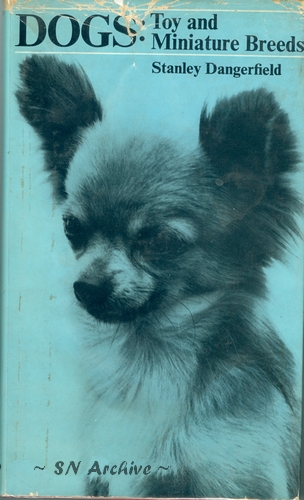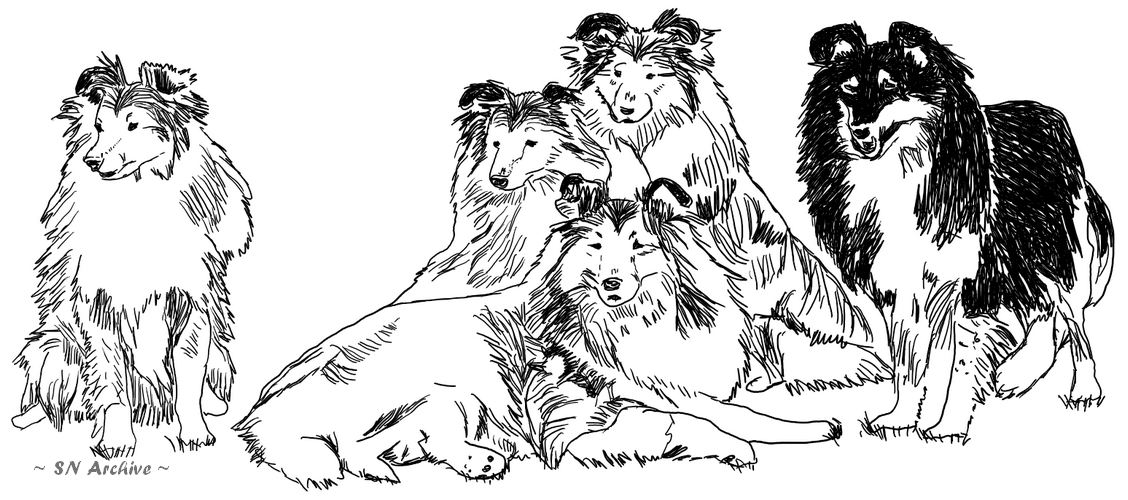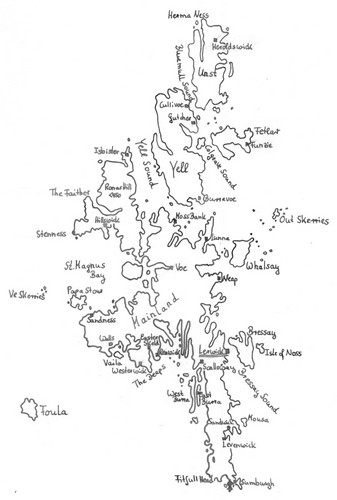 |
DOGS: Toy and Miniature Breeds Stanley Dangerfield, Arco Publications, GB, 1967 |
In Stanley Dangerfield's 155-page book there is a six-page chapter on the Shetland Sheepdog in Miniature Breeds with a black and white group photo by Sally Anne Thompson showing Ch. Riverhill Rare Gold with her four champion daughters Riverhill Ready Cash, Real Gold, Rather Rich and Rarity Of Glenmist (all after different sires). 
The author describes the Shetland Islands, the animals that lived there, mentions the breeds that were probably involved in their creation, discusses the appearance of the dogs of the time, addresses Kennel Club recognition and the objections of Collie fanciers. He mentions the Collie crosses and the different names given to our breed. With his reflections on the Sheltie character and appearance he addresses both the breeder and the puppy buyer. With concern he sees the growing popularity of the breed and points out the dangers involved. Interesting are his hints on blue merle breeding, which he does not want to see in the hands of amateurs.
Pages 94-99: "CHAPTER 19
The Shetland Sheepdog
THE point has been made and must be made repeatedly in a book dealing with toy and miniature dogs that fifty years ago the top dogs of the British Isles were the big dogs. A drift to the towns, smaller houses, and a changing way of life have regrettably made the majority of us forsake the giants of the past in favour of the pocket editions of the present.
This demand of smaller dogs has had two results. The first is that some breeds have been deliberately bantamized. For example, as mentioned in a previous chapter, the Standard Poodle was bred down first to the 'miniature' and then to the even smaller version, the 'toy'. Secondly, there has been a tremendous growth in popularity of those dogs, such as the Yorkshire Terrier which have always been diminutive although not always quite so popular.
The Shetland Sheepdog is in a slightly different category from either of those mentioned above. True, to some extent it had always been comparatively small but has only recently found favour with the masses. True also that it has been to some extent bantamized in comparatively recent years.
The difference is that the Shetland Sheepdog has been bantamized by nature. As its name implies, it is a working dog with a background in the Shetland Isles. The Shetland Isles are many miles north of the extreme tip of Scotland; thus, the Shetland Isles are at least near the Arctic Circle, but this is not to say that it is always cold. On the contrary, thanks to the Gulf Stream they frequently enjoy a warmer winter than does Scotland or even England. Life is hard there, however. Vegetation is sparse: gales, wind, rain and a comparatively short summer season attend to this. In addition, the soil is rocky and in any case the islands are small. This over the years has resulted in animals dwarfed by nature, the best known of which is the Shetland pony. Having mentioned this it is not necessary to add that to dwarf is not necessarily to make less robust.
In addition to the pony, however, the cattle are small and so are, or should one say were, the sheep. What then more natural than small dogs should be used to work these sheep? To some extent this demand was met by the importation of very small collies; almost certainly these dogs were later crossed with small island dogs and perhaps the lcelandic dog, a comparatively small, Spitz type of animal.
Given the small but nevertheless extremely fast and agile sheep, only small but agile dogs could herd them properly. The 'Sheltie', as we know, fulfils these requirements admirably and there have been stories of Shetland Sheepdogs so quick and eager to work that they have scrambled across the backs of these sheep so lightly and dextrously as to avoid panicking the flock.
Enough has been said to convey the impression that although the Shetland Sheepdog has always been small, it has not always existed in the present pure and attractive form we know today. On the contrary we know that some of the earlier dogs which came down from these islands were of comparatively nondescript appearance. The islanders' requirements were for work; beauty mattered little. This was comparatively unimportant as the islands were, in any case, until recent years quite isolated and there was therefore nobody from the outside world either to judge or to condemn them.
Not until the beginning of this century did they make very much impression other than in the isles. They were known originally as Shetland Collies, but this name gave rise to a good deal of ill feeling on the part of Rough Collie breeders who felt that for the island dogs to use their name was in some way a slight; be that as it may. When they were first recognized by the Kennel Club in 1909, the Breed Standard demanded that they should resemble Collies in miniature.
We know that to achieve this early breeders had resorted to crosses to the already well-established Scotch Collie. The aim was to give the island dogs style, quality, coats and finish. They succeeded in this but at the same time they inevitably sowed troubles, one of which persists to this day; that is a tendency for Shelties to grow over size.
Ideally, the Sheltie should be fourteen inches at the shoulder and most show specimens are. Pets however are usually a little larger, say fifteen inches, but even this is only the same size as the Miniature Poddle and therefor entitles the breed to be considered in this volume.
Before leaving the past, it should be said that they have been known by many names other than the original Shetland Collie, the present Shetland Sheepdog and the diminutive 'Sheltie'. For example their local name was 'Toonie dog', the 'Toon' being the name of a croft. They have also been known as 'Peerie' or 'Fairy dog'.
As with so many breeds their coat is their glory. And fortunately it is one that does not require a great deal of attention. It is certainly a feature of them which has brought them to the notice of the general public. Having observed them, it was soon appreciated that in addition to looking attractive, they were fleet of foot, graceful, alert and hardy, equally at home in the town and country, easy to feed and of gay disposition.
These dogs which have come so far in this country may well have even further to go in the foreseeable future. For example, in recent years their numbers have multiplied annually. In the first full year after the war approximately six hundred were registered with the Kennel Club. By 1959 this had risen to 2,700. By 1965 this number had risen once again to a little over five thousand, and in doing so it has taken the Shetland Sheepdogs into the elite of the 'Top Ten' most popular dogs in Great Britain.
The question is 'Where will it end?' Another perhaps more important question is, 'Will this surge of popularity bring in its train the almost invariable drawbacks and disadvantages?' The answer is that the latter do not necessity make their appearance but great care will be needed from all breeders, and for that matter the purchasers of pets, if the obvious problems are to be avoided.
The best adivse that one can give, therefore, is that before you buy a Sheltie puppy you should stop, look and think.This is an advise that a responsible breeder would cavil at. It is a great mistake to buy a dog with a poor temperament. When the Sheltie is good in this respect he is very, very good, but when he is bad he really is bad. The risk with Shetland Sheepdogs is not that they will be aggressive but that they can be so nervous and highly strung that it is to be doubted whether they get any pleasure from life. Quite certainly they can give very little, even to their owners.
By avoiding these, and the signs are there for all who have eyes to see, breeders will be compelled to consider their breeding programmes more carefully, as few of them will take the chance of producing puppies which they cannot sell. 'Reserve' and 'suspicion' are all very well, but these words should not be allowed to cover too great a multitude of sins. Always the buyer should remember that the greatest single asset of the breed is their trainability. For centuries the best of them have worked with and for man. It is their nature to obey willingly, naturally and with the minimum of instruction. To them man is both god and master. In case this should appear fanciful, let it be said that there is practical evidence of their trainability for the asking.
A surprisingly high number of them have been trained for obedience work and take part regularly in competitions at the major dog shows in Great Britain. Perhaps even more surprising, a number of them have become obedience champions (one of the most difficult to win of all titles) and a feat made even all the more remarkable when one considers that to achieve this they must often beat scores of Alsatians, a breed which is renowned throughout the world for its brilliant working qualities.
The Shetland Sheepdog is bred in three main colours. The first is sable, that is a sort of tan colour which can vary from the pale gold to a dark mahogany, and frequently this is mixed with white. Next come the tri-colour where the body of the dog is mainly black with white and tan markings. Finally, comes the Blue Merle, in many ways the most attractive, colourful and picturesque of all. In this variety the black is interspersed with the white so finely as to give an impression of blue marble. Many of these Blue Merles have normal eyes; occasionally, however, one sees a wall or china eye - that is, an eye which is blue and white rather like a willow plate. Many people like this but frankly the author admits that it is in any case a question of taste.
A word of warning is necessary to those who would breed Blue Merles - it is that they are not for amateurs. The breeder of this variety should know what he is doing and when to stop. The colour is to some extent a signal that nature is being stretched to the limit and it is known and admitted that if white predominates in a so-called Blue Merle, there is more than a risk of deafness and blindness.
Lastly we come to the two most appealing features of this very appealing breed; first the eye, a neat, sweet, dark, almond shaped eye, with something approaching a smile in it. Quite wrong is a round, staring or hard eye; then to the ears. Once again neat, sweet, expressive and just tilted at the tips - a characteristic which emphasizes the alert character of the breed. Sad but true, a Sheltie with erect ears - that is ears pricked and pointed to heaven, has lost, through no fault of its own, the very essence of the breed.
ABBREVIATED BREED STANDARD
... "
If you discover any errors in the text that may have been caused by the transcription, please let us know for a prompt correction.

